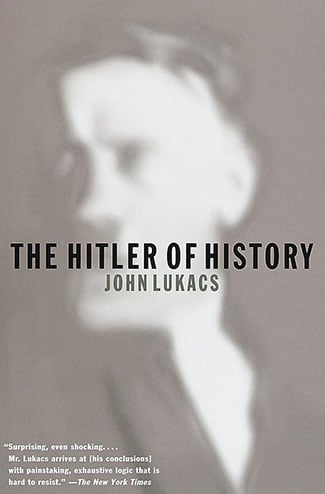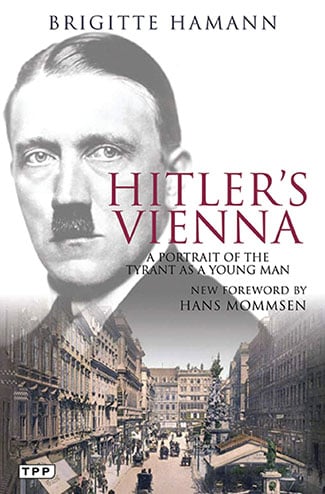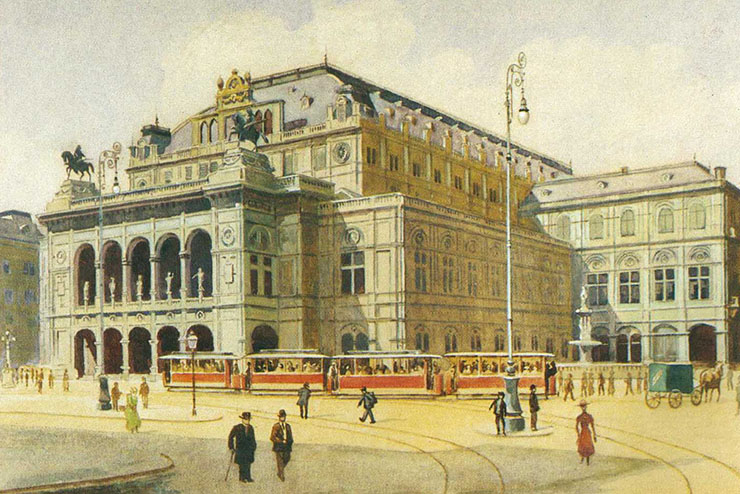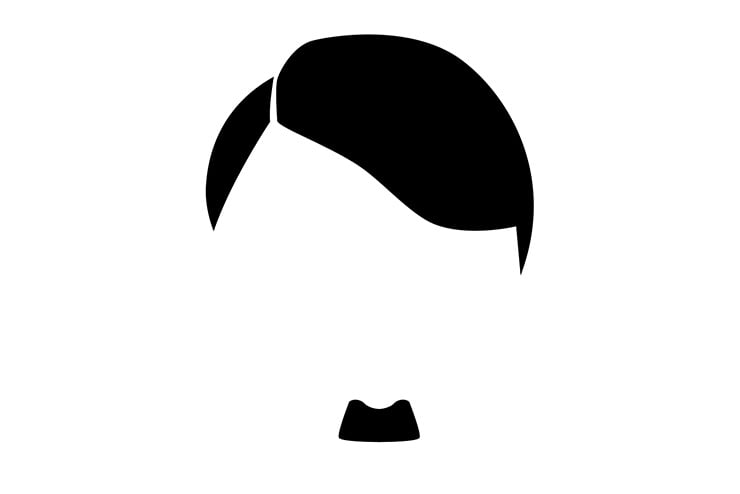In 1997, John Lukacs published The Hitler of History, a book that presents a provocative but also reasonable argument: Contrary to the standard view of historians, Hitler was not a conservative who embodied the values of the pre-World War I German ruling class. He was in fact a radical revolutionary who felt nothing but contempt for the political and social order of Imperial Germany and who rejoiced at its abolition after Germany’s defeat in 1918. According to Lukacs, Hitler was not a German patriot or old-fashioned monarchist but an expansionist nationalist who appealed to the masses directly, over the heads of traditional German elites.
Lukacs’s perspective challenged what has been known as the “continuity thesis,” dominant among postwar historians. English historian A.J.P. Taylor previewed the continuity thesis in his World War II propaganda tract, The Course of German History (1945). According to Taylor’s brief, which I heard restated ad nauseam as a graduate student, German history exhibits a reactionary, antidemocratic pattern that inescapably culminated in Hitler’s dictatorship and its ensuing catastrophes. Particularly since the “antiliberal” unification of Germany in the 19th century, Taylor saw Germany’s journey toward a reactionary abyss as preordained.
Lukacs’s reinterpretation of Hitler as a revolutionary, not a German reactionary, was entirely correct. It is a reading that receives exhaustive treatment in the books of German historian Rainer Zitelmann, whom Lukacs consulted in doing his research. Zitelmann provides striking quotations—from Hitler’s speeches, correspondence, and “Table Talk” remarks recorded by his subordinates—that prove how radically anti-traditional Hitler really was. Zitelmann also produced works documenting the palpably anti-traditional nature of Hitler’s iconoclastic worldview, including statements in which Hitler deplored the fact that the overthrow of the last Kaiser in November 1918 did not go far enough in revolutionizing Germany.

Unfortunately for Zitelmann, his work didn’t fit the politically motivated antifascist German narrative prevalent in his native country. Germans, and now Americans, are supposed to believe that Hitler was a German ultraconservative, pursuing the policies of the founders of the German Second Empire, proclaimed in January 1871. He was supposedly a backward-looking fanatic, who believed in invented racial theories and Nordic myths but not in the “scientific progress” characteristic of the left. Zitelmann demonstrates something very different: that, like leftists of his age, Hitler was a scientific materialist who worshipped “science.”
Lukacs adopted Zitelmann’s depiction of Hitler both because it clarified the historical picture and because a revolutionary Hitler was a useful foil for his all-time hero, Winston Churchill, with whom Lukacs contrasted the Austro-German tyrant in several of his books. Whereas Lukacs portrayed Churchill as a true patriot and admirable reactionary, he depicted Hitler as a crude populist and unbridled revolutionary. Lukacs was deeply suspicious of nationalism and populism, and he viewed Hitler as an ominous prototype of the populist demagogue who might one day capture the American political imagination.
Although Lukacs did not live to see the rise of Donald Trump, the latter might have been considered by Lukacs to be the kind of dangerous populist whom Hitler exemplified in a more extreme form. Lukacs shared at least some of the sensibilities of the liberal establishment of his day, which may be why that establishment relished his books. But he came to his establishment position as a Central European of gentry stock (on his father’s side) who felt misgivings about popular rule, like his aristocratic Austrian friend, Erik von Kuehnelt-Leddhin (whose position Lukacs took at Chestnut Hill College after Kuehnelt-Leddhin went back to Austria).
Anti-egalitarian sentiment in Kuehnelt-Leddhin’s case led to explicit contempt for the left, and he therefore had no trouble viewing Hitler, Robespierre, and Mao as all being cut from the same evil cloth. Lukacs’s case, however, was more complicated. He longed for an “establishment” that would protect polite society from democratic demagoguery, something he almost always associated with the right. Lukacs’s admiration for the American patrician George F. Kennan, who managed to be both socially reactionary and bitterly critical of America’s anti-communist right, suited well Lukacs’s complicated ideological disposition.

Not surprisingly, Zitelmann left his original field of study to become a real estate broker in Berlin, a vocation in which he did quite well. He is now producing books once again, but not in his original area of research. Rather, he is writing in defense of the free market, as a disciple of Austrian School economist Ludwig von Mises.
To say that Zitelmann felt unwelcome in his country as an historian of Hitler and the Third Reich would be an understatement. Although a gifted stylist and diligent researcher, he violated the continuity thesis embraced by German journalists and politicians.
The continuity thesis also complemented the Western postwar liberal democratic platform. In this view, because the German Constitution, enacted after German unification in 1871, vested too much power in the emperor and his chancellor and too little power (outside of controlling the purse) in the popular assembly (the Reichstag), and because the German military and administration remained largely in aristocratic hands, a “democracy deficit” put the Germans on a dangerous historic path that ended in the Third Reich.
Jonathan Steinberg, an American biographer of the first Imperial Chancellor, Otto von Bismarck, expressed this continuity thesis with admirable concision: “Bismarck’s legacy passed through [World War I German General and later President Paul von] Hindenburg, to the last genius statesman that Germany produced, Adolf Hitler, and the legacy is thus linear and direct between Bismarck and Hitler.”
Lest anyone doubt Steinberg’s portentous narrative, the very antifascist, antinationalist German president, Frank-Walter Steinmeier, has repeated its main points with monotonous regularity. Steinmeier presents the entire German past as necessarily pointing toward Auschwitz. The German president has also made a habit of visiting foreign capitals, like Warsaw and Jerusalem, to express regret for German history and even for the fact that he speaks in his native language, given the enormous guilt that has accrued to his people.
Such a now-authorized view of the German past draws from a particular interpretation of Hitler’s life and personality. Not accepting this interpretation can exact a heavy price for a scholar. Zitelmann’ s portrait of Hitler as a modern revolutionary clearly clashes with the teachings of Germany’s state-of-the-art “democracy,” which requires that the depiction of Hitler and his rule be presented as the fruits of a specifically German reactionary past. The playing out of that past, we are told, preceded the Allied “liberation” of the Germans in 1945, a step that led to the repression, if not total extirpation, of the German authoritarian character and to Germany’s now perpetual role as repentant sinner. This role has necessitated a faithful imitation of whatever is considered to be “Western,” most recently accomplished by enacting the rituals of the American woke left. Being “democratic” in Germany also now means a continuing denunciation of the present Russian and Hungarian governments as “authoritarian” for their rejection of the LGBT agenda.
According to this received “democratic” teaching, Hitler was a typical anti-Semitic, antidemocratic German or Austrian nurtured by an antidemocratic society. He grew up in the provincial Austrian town of Braunau am Inn surrounded by Jew-hating German nationalists, and his authoritarian father, unlike his sorely browbeaten mother, bullied him mercilessly. Here we may note that this psychological profile gets its inspiration from the influential book The Authoritarian Personality, published by members of the Frankfurt School in 1950, which portrays right-wing thought as the result of mental illness induced by childhood trauma.
It is a matter of record that Hitler left Linz, in Upper Austria, in 1909 to pursue studies as an artist and settled in Vienna, where he remained until 1913. While in this supposed hotbed of bigotry, he allegedly became imbued with the anti-Semitic and anti-Slavic passions that infected the Austrian capital. Of course, by the time Hitler slipped over the border and settled in Munich in 1913, he was already scarred, as we have been made to believe, by the mentality of the Germano-Austrian political and social world of the early 20th century. That pernicious mentality was just waiting to express itself in the future German dictator, and when he joined the German National Socialist Workers’ Party after World War I, he was already eager to carry out his quintessentially German mission, which involves mass murder and genocide as a matter of course.

Significantly, the description of the English translation of Brigitte Hamann’s monograph, Hitler’s Vienna: A Portrait of the Tyrant as a Young Man, which was published in German in 1996, includes these details:
Hitler’s was not the modern, artistic “fin-de-siècle Vienna” we associate with Freud, Mahler, Schnitzler, and Wittgenstein. Instead, it was a cauldron of fear and ethnic rivalry, a metropolis teeming with “little people” who rejected Viennese modernity as too international, too libertine, and too Jewish. It was a breeding ground for racist political theories, where one leading member of parliament said, to the cheers of his colleagues, “I would like to see all Jews ground to artificial fertilizer.”
Brigitte Hamann vividly depicts the undercurrent of disturbing ideologies that flowed beneath the glitter of the Hapsburg capital. Against this background, Hamann tells the story of the moody, curious, intense, painfully shy young man from the provinces, Adolf Hitler.
The ground-breaking argument in Hamann’s work is exactly the opposite of what this English summary states. According to the actual book, the young Hitler was very much part of the “fin-de-siècle” Vienna that we associate with Mahler and other Jewish or quasi-Jewish cultural figures. He hung out with the cultural avant-garde during his Vienna years and even demonstrated against the putatively anti-Semitic opponents of Mahler’s music. (Although a Catholic, Mahler was of Jewish ancestry.) There was in fact nothing in Hamann’s treatment of “the apprenticeship of a dictator,” that suggests the vicious behavior of the later Hitler, who, in Vienna, was an unsuccessful painter of local scenes but hardly a raving bigot.
There was furthermore nothing ominous about Hitler’s upbringing. From available records, we learn that his parents were by no means fanatically intolerant Catholics, despite the claims made by the “new atheists” Christopher Hitchens, Sam Harris, and Richard Dawkins. Such crusading non-deists imagined that the Christian theism they ascribe to Hitler drove him into religious bigotry and mass murder. In point of fact, Alois and Klara Hitler were conventional Austrian Catholic churchgoers, and one of their close family friends was the local Jewish physician, Eduard Bloch, who looked after Hitler’s widowed mother after she became fatally ill with cancer. Hitler also had a sister who grew up in similar domestic circumstances but who never exhibited the nasty qualities associated with her brother after his rise to power.

Another German historian who, like Zitelmann and Hamann, doesn’t stick to prescribed narratives is Ralf Georg Reuth. In his book, Hitlers Judenhass: Klischee und Wirklichkeit (Hitler’s Hatred of Jews: Cliche and Reality), Reuth shows exhaustively that Hitler’s ferocious hatred of Jews resulted from his being present during the Communist takeover of Munich in 1919. According to Reuth, there is exceedingly little evidence of Hitler’s genocidal anti-Semitism until he reacted to the brutal Communist dictatorship established in Munich in the wake of the German defeat in World War I.
The Communist Council Republic (Räterepublik), which took control of Munich in early April 1919, was led by Russian Jewish Bolsheviks, most importantly Eugen Leviné, who was killed after the counterrevolutionaries took back the city in May. The earlier radical government that established itself in Munich (but not uniformly in the rest of Bavaria) after the collapse of the German Empire and Bavarian monarchy in early November 1918 had also featured Jewish radicals Kurt Eisner, Gustav Landauer, and Ernst Toller. Jewish overrepresentation in postwar revolutionary activity fed a wave of anti-Semitism in Germany, Austria, and Hungary. (In significant contrast to the widespread impression at the time, most Jews in Central Europe had no noticeable sympathy for the Communists. Many, in fact, sympathized with the counterrevolutionaries.)
Hitler did make “Jewish Bolshevism” the keystone of his politics, but he came to this position in a strange way. From all indications, he supported the revolution in Munich and even had himself elected to a “Council of Soldiers.” After Leviné and other foreign Bolsheviks who had taken over the Bavarian revolution were driven from power and their revolutionary government crushed, Hitler changed sides quite opportunistically. He not only abandoned his many Jewish friends, some of whom were leftist revolutionaries, but also became fixated on a pervasive Jewish threat to Germany’s existence.
Reuth attributes this behavior, at least partly, to self-defense. Hitler was trying to hide his own association with the Munich revolution by expressing, in an extreme form, the anti-Semitism that was then surging throughout Europe in the wake of postwar Communist uprisings. He jumped on this issue and made it his own in an obsessive way. In any case, Hitler attributed both the punitive peace treaty suffered by Germany as a defeated power and Communist internationalism to a pervasive Jewish influence. He also included Jewish capitalists in this web of evil, which came together in his mind as he watched events unfold in Munich. Finally, Hitler came to view himself as the savior of his country and thought his theatrical oratorical skills, which he had already been honing, would allow him to play a “providential role” in the resurrection of his country.

(public domain)
What is certainly not demonstrable, according to Reuth, is that Hitler’s anti-Semitic fixation can be traced back to his youth in Braunau or to the years that he struggled financially in Vienna. It is only fair to point out that other biographers of Hitler, most notably Joachim Fest, also underline the transformative nature of Hitler’s experience in postwar Munich. But unlike other biographers, Reuth demonstrates that Hitler changed his political direction in response to the suppression of a revolution that he had actually welcomed.

Not surprisingly, Hitler’s partly autobiographical Mein Kampf, which was published in July 1925, includes details about his life in Vienna and his military service that correspond to the accounts given by Fest, Ian Kershaw, and other Hitler biographers. But these accounts, as Reuth points out, were produced after Hitler’s opportunistic embrace of anti-Semitism and do not jibe with certain documentable facts, such as Hitler’s friendship with Jews, including revolutionary leftist ones, and his active support of revolutionary events in Munich in 1919. One might also ask why ferocious critics of Hitler have been so willing to accept at face value Hitler’s politically colored narratives about his early life, which he produced to advance his career as an anti-Semitic politician. Reuth is correct to ask why curiosity had not impelled these biographers to probe more deeply into their subject’s fixation.
In conclusion, I am not suggesting that Hitler was not a brutal tyrant, nor am I saying that there were no circumstances in post-World War I or in earlier German society that allowed him to take power more easily than might have been the case elsewhere. In England, for example, which had stronger parliamentary traditions, a totalitarian takeover would have been less likely, even if the English, instead of the Germans, had suffered defeat in World War I. The Germans, it may be conceded, lacked the constitutional and civic resources to withstand the totalitarian nightmare that descended on their country in the 1930s.
But none of this suggests that German society was moving inexorably from the 19th or early 20th century toward the grim end that it reached with Hitler’s accession to power in January 1933. Nor can it be shown that Hitler became a maniacal despot because he was steeped from earliest childhood in an evil German culture. The attempt to depict his life in this manner is ideologically driven. It is an effort to paint the German past in such a way as to justify the antifascist social control of the present German government.
This received account of Hitler’s life also is meant to legitimize a government that is busy rooting out the remnants of the German past, an enterprise that is entirely compatible with the Hitler of legend. This strenuous attempt to reconstruct society and politics in the name of overcoming an evil past is of course no longer exclusively German. It has become the shared destiny of both the defeated powers and the Western victors in the World Wars. What the Germans call a Schicksalsgemeinschaft, or a “community of fate,” now links the two.

Leave a Reply